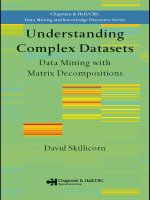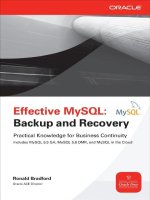IT training thenewstack book5 monitoring and management with docker and containers khotailieu
Bạn đang xem bản rút gọn của tài liệu. Xem và tải ngay bản đầy đủ của tài liệu tại đây (1.46 MB, 84 trang )
5
vol.
MONITORING
& MANAGEMENT
WITH
DOCKER
& CONTAINERS
EDITED & CURATED BY ALEX WILLIAMS
The New Stack:
The Docker and Container Ecosystem Ebook Series
Alex Williams, Founder & Editor-in-Chief
Benjamin Ball, Technical Editor & Producer
Gabriel Hoang Dinh, Creative Director
Lawrence Hecht, Data Research Director
Contributors:
Judy Williams, Copy Editor
Norris Deajon, Audio Engineer
v 5.1
TABLE OF CONTENTS
Sponsors ........................................................................................................................................ 4
Introduction .................................................................................................................................. 5
MONITORING & MANAGEMENT WITH DOCKER & CONTAINERS
Monitoring Reset for Containers................................................................................................ 8
IBM: Creating Analytics-Driven Solutions for Operational Visibility .................................23
Classes of Container Monitoring .............................................................................................24
Docker: Building On Docker’s Native Monitoring Functionality........................................40
Identifying and Collecting Container Data ............................................................................41
Sysdig Cloud: The Importance of Having Visibility Into Containers .................................55
The Right Tool for the Job: Picking a Monitoring Solution ................................................56
Cisco:
.........................63
Managing Intentional Chaos: Succeeding with Containerized Apps ...............................64
CONTAINER MONITORING DIRECTORY
Container-Related Monitoring .................................................................................................72
Components/Classes of Monitoring Systems ......................................................................75
Management/Orchestration ...................................................................................................79
Miscellaneous .............................................................................................................................81
Disclosures...................................................................................................................................83
MONITORING & MANAGEMENT WITH DOCKER & CONTAINERS
3
SPONSORS
We are grateful for the support of the following ebook series sponsors:
And the following sponsor for this ebook:
MONITORING & MANAGEMENT WITH DOCKER & CONTAINERS
4
INTRODUCTION
As we’ve produced The Docker & Container Ecosystem ebook series, it
feels like container usage has become more normalized. We talk less
about the reasons why to use and adopt containers, and speak more to
the challenges of widespread container deployments. With each book in
the series, we’ve focused more on not just moving container workloads
into production environments, but keeping those systems healthy and
operational.
With the introduction of containers and microservices, monitoring
solutions have to handle more ephemeral services and server instances
than ever before. Not only are there more objects to manage, but they’re
generating more pieces of information. Collecting data from environments
composed of so many moving parts has become increasingly complex.
Monitoring containerized applications and environments has also moved
beyond just the operations team, or at the very least has opened up to
more roles, as the DevOps movement encourages cross-team
accountability.
This book starts with a look at what monitoring applications and systems
has typically meant for teams, and how the environments and goals have
changed. Monitoring as a behavior has come a long way from just keeping
computers online. While many of the core behaviors remain similar, there’s
necessities of containerized environments.
Moving beyond historical context, we learn about the components,
behaviors, use cases and event types that compose container monitoring.
MONITORING & MANAGEMENT WITH DOCKER & CONTAINERS
5
INTRODUCTION
breakdown includes a discussion about metrics-based monitoring
systems, and how the metrics approach constitutes a series of functions
such as collection, ingestion, storage, processing, alerting and visualization.
Another major focus of this book is how users are actually collecting the
monitoring data from the containers they’re utilizing. For some, the data
collection is as simple as the native capabilities built into the Docker
engine. Docker’s base monitoring capabilities are almost like an agnostic
tools for data collection, which range from self-hosted open source
containers. We also discuss how users and teams can pick a monitoring
We cover how containerized applications and services can be designed
with consideration for container-native patterns and the operations teams
that will manage them. Creating applications that are operations-aware
will enable faster deployment and better communication across teams.
This kind of focus means creating applications and services that are
designed for fast startups, graceful shutdowns and the complexity of
container management systems.
Much like the container ecosystem itself, the approaches to monitoring
containers are varied and opinionated, but present many valuable
opportunities. The monitoring landscape is full of solutions for many
include many open source and commercial solutions that range from
native capabilities built into cloud platforms to cloud-based services
purpose-built for containers. We try to cover as many of these monitoring
perspectives as possible, including the very real possibilities of using more
than one solution.
MONITORING & MANAGEMENT WITH DOCKER & CONTAINERS
6
INTRODUCTION
While this book is the last in its series, this by no means our last
publication on the container ecosystem. If anything, our perspective on
how to approach this landscape has changed drastically — it seems
almost impossible not to try and narrow down the container ecosystem
into more approachable communities. If we’ve learned anything, it’s that
consistently portray.
into new areas of focus, such as Docker, Kubernetes and serverless
technologies. Expect to see more from us on building and managing scale
Docker and containers, and we hope you’ve learned a few things as well.
I’d like to thank all our sponsors, writers and readers for how far we’ve
come in the last year, and we’ll see you all again soon.
Thanks,
Benjamin Ball
Technical Editor and Producer
The New Stack
MONITORING & MANAGEMENT WITH DOCKER & CONTAINERS
7
MONITORING RESET FOR
CONTAINERS
by LAWRENCE HECHT
M
onitoring is not a new concept, but a lot has changed about the
systems that need monitoring and which teams are responsible
for it. In the past, monitoring used to be as simple as checking if
Charles remembers monitoring as simple instrumentation that came
alongside a product.
As James Turnbull explains in The Art of Monitoring, most small
organizations didn’t have automated monitoring — they instead focused
on minimizing downtime and managing physical assets. At companies
on dealing with emergencies related to availability. Larger organizations
eventually replaced the manual approach with automated monitoring
systems that utilized dashboards.
Even without the introduction of containers, recent thought leaders have
advocated that monitoring should more proactively look at ways to
improve performance. To get a better view of the monitoring environment,
MONITORING & MANAGEMENT WITH DOCKER & CONTAINERS
8
MONITORING RESET FOR CONTAINERS
Analysis of Monitoring Status Quo Circa 2015
Survey Results
Nagios was the most widely used tool, followed
by Amazon CloudWatch and New Relic. A second
tier of products included Incinga, Sensu, Zabbix, Datadog,
Riemann and Microsoft System Center Operations Manager.
Server infrastructure was monitored by 81 percent
of the respondents.
Analysis
usage has increased.
operations teams.
collectd, StatsD and New Relic were the most
common products used to collect metrics. That data
Graphite. Although used less
often, time series databases
and
also represented in the study.
Grafana was most used for visualization
Graphite.
corporate parent.
TABLE 1: New monitoring solutions compare themselves favorably to the commonly
used Nagios and Graphite applications.
we reviewed a survey James Turnbull conducted in 2015. Although it is a
snapshot of people that are already inclined to care about monitoring, it
provides many relevant insights.
in their stack. While monitoring may always been relatively time
consuming, there are approaches that can improve the overall experience.
To understand how to monitor containers and their related infrastructure,
aspects of containerized environments that change previously established
MONITORING & MANAGEMENT WITH DOCKER & CONTAINERS
9
MONITORING RESET FOR CONTAINERS
solutions. Understanding these changes will help explain how vendors are
varied team of users involved in monitoring. The monitoring changes that
1. The ephemeral nature of containers.
2. The proliferation of objects, services and metrics to track.
3. Services are the new focal point of monitoring.
4. A more diverse group of monitoring end-users.
5. New mindsets are resulting in new methods.
Ephemerality and Scale of Containers
Cloud-native architectures have risen to present new challenges. The
temporary nature of containers and virtual machine instances presents
tracking challenges. As containers operate together to provide
monitoring to make observations about their health. Due to their
ephemeral nature and growing scale, it doesn’t make sense to track the
the health of individual containers; instead, you should track clusters of
containers and services.
Traditional approaches to monitoring are based on introducing data
collectors, agents or remote access hooks into the systems for
monitoring. They do not scale out for containers due to the additional
complexity they introduce to the thin, application-centric encapsulation
of containers. Neither can they catch up to the provisioning and dynamic
scaling speed of containers.
MONITORING & MANAGEMENT WITH DOCKER & CONTAINERS
10
MONITORING RESET FOR CONTAINERS
In the past, people would look at a server to make sure it was running.
They would look at its CPU utilization and allocated memory, and track
network bottlenecks with I/O operations. The IT operator would be able
to know where the machine was, and easily be able to do one of two
collect data. In monitoring language, this is called polling a machine.
Alternatively, an agent can be installed on the server, which then pushes
data to a monitoring tool.
This push approach has achieved popularity because the ephemeral
from the key observability characteristics of containers, and enables
container execution.
Proliferation of Objects, Services and Metrics
to Track
The explosion of data being generated is a well known phenomenon. Ten
years ago, people cared about how to store all that data. More recently,
the focus has been on how to best utilize that data without storing it all.
there are now more and more objects than ever to monitor. While there is
an instinct to try to corral all these objects into a monitoring system,
others are attempting to identify new units of measurement that can be
more actionable and easily tracked.
The abundance of data points, metrics and objects that need to be
tracked is a serious problem. Streaming data presents many opportunities
for real-time analytics, but it still has to be processed and stored. There
MONITORING & MANAGEMENT WITH DOCKER & CONTAINERS
11
MONITORING RESET FOR CONTAINERS
databases have established their place in the IT ecosystem, they are not
optimized for this use case; time series databases is a potential solution
motivating users to focus less on log management tools and more on
metrics, which is data collected in aggregate or at regular intervals.
Containers present two problems in terms of data proliferation. Compared
to traditional stacks, there are more containers per host to monitor and
the number of metrics per host has increased. As CoScale CEO Stijn
host: 100 about the operating system and 50 about an application. With
containers, you’re adding an additional 50 metrics per container and 50
metrics per orchestrator on the host. Considering a scenario where there
a cluster is running 100 containers on top of two underlying hosts, there
would be over 10,000 metrics to track.
With so much potential data to collect, users focus on metrics. As
Honeycomb co-founder and engineer Charity Majors wrote, “Metrics are
Per Host Metrics Explosion
Component
# of Metrics for a
Traditional Stack
for 10 Container Cluster
with 1 Underlying Host
for 100 Container Cluster
with 2 Underlying Hosts
Operating System
100
100
200
Orchestrator
n/a
50
50
Container
n/a
500 (50 per container)
5,000 (50 per container)
Application
50
500 (50 per container)
5,000 (50 per container)
Total # of Metrics
150
1,150
10,250
TABLE 2: Containers means more metrics than traditional stacks.
MONITORING & MANAGEMENT WITH DOCKER & CONTAINERS
12
MONITORING RESET FOR CONTAINERS
about individual events in exchange for cheap storage. Most companies
are drowning in metrics, most of which never get looked at again. You
cannot track down complex intersectional root causes without context,
and metrics lack context.” Even though metrics solve many operations
problems, there’s still too many of them, and they’re only useful if they’re
actually utilized.
Services Are the New Focal Point
With a renewed focus on what actually needs to be monitored, there are
three areas of focus: the health of container clusters; microservices; and
applications.
Assessing clusters of containers — rather than single containers — is a
better way for infrastructure managers to understand the impact services
will have. While it’s true that application managers can kill and restart
individual containers, they are more interested in understanding which
clusters are healthy. Having this information means they can deploy the
its optimal operation. Container orchestration solutions help by allowing
Many microservices are composed of multiple containers. A common
place. However, if this failure is a consistent pattern in the long-term, there
will be a degradation of the service. Looking at the microservice as a unit
can provide insight into how an entire application is running.
According to Dynatrace Cloud Technology Lead Alois Mayr, in an interview
with The New Stack, when looking at application monitoring, “you’re
mostly interested in the services running inside containers, rather than the
containers themselves. This application-centric information ensures that
MONITORING & MANAGEMENT WITH DOCKER & CONTAINERS
13
MONITORING RESET FOR CONTAINERS
the applications being served by the component containers are healthy.”
Instead of just looking at CPU utilization, you want to look at CPU time
response times; and track communication between microservices across
containers and hosts.
More Diverse Group of Monitoring End-Users
The focus on monitoring applications instead of just infrastructure is
happening for two reasons. First, a new group of people is involved in
the monitoring. Second, applications are more relevant to overall
business performance.
Monitoring is still generally reactive, despite progress in recent years. It’s
focused on the objectives of the IT team managing the actual
infrastructure. This mindset does a disservice to developers because they
generally receive data secondhand. Developers are increasingly being held
accountable for applications once they have been put into production. As
Todd DeCapua and Shane Evans’s
performing product, and provide continuous feedback and optimization
automated ways.” The DevOps movement has risen, at least in part, as a
response to developers’ desire for increased visibility throughout the full
and operators of applications.
analysis of the aforementioned Turnbull survey of IT professionals that
care about monitoring shows that beyond servers, their areas of interest
DevOps roles. Based on the survey, 48 percent of developers monitor
MONITORING & MANAGEMENT WITH DOCKER & CONTAINERS
14
MONITORING RESET FOR CONTAINERS
87%
89%
94%
Server Infrastructure
48%
Cloud Infrastructure
65%
53%
50%
Network Infrastructure
Application Logic
DevOps
56%
27%
0
20%
Sysadmin/Operations/SRE
72%
59%
Business Logic
Developer
70%
75%
38%
38%
40%
60%
80%
100%
Source: The New Stack Analysis of a 2015 James Turnbull survey. Which of the following best describes your IT job role? What parts of your
environment do you monitor? Please select all the apply. Developers, n=94; DevOps, n=278; Sysadmin/Operations/SRE, n=419.
FIG 1: DevOps care more about monitoring cloud infrastructure (65 percent) and ap-
plication logic (75 percent) as compared to their IT operations-focused peers.
by DevOps roles.
data showed that 72 percent of system admins and IT Ops roles monitor
networking infrastructure, which is about 20 percentage points higher
than the developers and DevOps groups. On the reverse side, 70
percent of developers and 75 percent of DevOps roles monitor
application logic, compared to only 59 percent of the IT operationsoriented respondents.
DevOps roles care as much about applications as they do infrastructure,
but care more about performance than availability. As James Turnbull
writes in The Art of Monitoring:
MONITORING & MANAGEMENT WITH DOCKER & CONTAINERS
15
MONITORING RESET FOR CONTAINERS
“
Orienting your focus toward availability, rather than quality and
service, treats IT assets as pure capital and operational expenditure.
They aren’t assets that deliver value, they are just assets that need to
be managed. Organizations that view IT as a cost center tend to be
happy to limit or cut budgets, outsource services, and not invest in
new programs because they only see cost and not value.”
Luckily, we’ve seen a trend over the last few years where IT is less of a
cost center and more of a revenue center. Increased focus on
performance pertains to both IT and the business itself. Regarding IT,
utilization of storage or CPU resources is relevant because of their
associated costs. From the perspective of the business itself, IT used to
availability and resolvability are still critical, new customer-facing metrics
are also important.
will still largely be managed by an operations team, but responsibility for
ensuring new applications and services are monitored may be delegated
interview with The New Stack that SREs and DevOps engineers are
the management of services, thus creating more specialization. Dan
with The New Stack that he believes DevOps positions are replacing
looking at things from a data center perspective. If the old-school
networking stats are being displaced by cloud infrastructure metrics,
then this may be true.
MONITORING & MANAGEMENT WITH DOCKER & CONTAINERS
16
MONITORING RESET FOR CONTAINERS
The market is responding to this changing landscape. Sysdig added teams
their orchestration system. While this may solve security issues, the main
roles. Another example of role-based monitoring is playing out in the
Kubernetes world, where the project has been redesigning its dashboard
operators and cluster operators.
New Mindset, New Methods
is also moving to a more holistic approach. As Majors wrote on her blog,
move towards the “observability” of systems. This has to happen because
tools are needed to keep pace and provide the ability to predict what’s
Observability recognizes that testing won’t always identify the problem.
Thus, Majors believes that “instrumentation is just as important as unit
tests. Running complex systems means you can’t model the whole thing
in your head.” Besides changes in instrumentation, she suggests focusing
on making monitoring systems consistently understandable. This means
as your peers do both within and outside the organization. Furthermore,
there is a frustration with the need to scroll through multiple, static
dashboards. In response, vendors are making more intuitive, interactive
what information displays when for each service.
MONITORING & MANAGEMENT WITH DOCKER & CONTAINERS
17
MONITORING RESET FOR CONTAINERS
Approaches to Address the New Reality
Increasing automation and predictive capabilities are common
approaches to address new monitoring challenges.
Increasing automation centers around reducing the amount of time it
takes to deploy and operate a monitoring solution. According to Steven
interview with The New Stack, the larger the organization, the more likely
from all their inputs and applications. Vendors are trying to reduce the
a monitoring agent is installed on a host, you don’t have to think about it.
More likely, it means that the tools have the ability to auto-discover new
applications or containers.
You also want to automate how you respond to problems. For now, there
to create automated alerts, but now the alerts are more sophisticated. As
James Turnbull says in his book, alerting will be annotated with context
and recommendations for escalations. Systems can reduce the amount
of unimportant alerts, which mitigates alert fatigue and increases the
likelihood that the important alerts will be addressed. For now, the focus
is getting the alerts to become even more intelligent. Thus, when
someone gets an alert, they are shown the most relevant displays that
are most likely to identify the problem. For now, it is simply faster and
a case by case basis.
Automating the container deployment process is also related to how you
monitor it. It is important to be able to track the setting generated by your
MONITORING & MANAGEMENT WITH DOCKER & CONTAINERS
18
MONITORING RESET FOR CONTAINERS
help. Kubernetes, Mesos and Cloud Foundry all enable auto-scaling.
Just as auto-scaling is supposed to save time, so is automating the
recognition of patterns. Big Panda, CoScale, Dynatrace, Elastic Prelert, IBM
Bluemix, Netsil and SignalFx are just a few of the companies that use
result is that much of the noise created by older monitoring approaches
gets suppressed. In an interview with The New Stack, Peter Arjis of
CoScale says anomaly detection means you don’t have to watch the
dashboards as much. The system is supposed to provide early warnings
applications and infrastructure behave.
applications to identify the root cause of the problem. Looking at an
impacted service, it automatically measures what a good baseline would
monitoring system either gets alerted or gets presented with a possible
resolution in the dashboard.
Finding the Most Relevant Metrics
The number of container-related metrics that can be tracked has increased
dramatically. Since the systems are more complex and decoupled, there is
more to track in order to understand the entire system. This dramatically
changes the approach in monitoring and troubleshooting systems.
Traditionally, availability and utilization of hosts is measured for CPUs,
managing IT infrastructure, they do not provide the best frame of
reference for evaluating what metrics to collect.
MONITORING & MANAGEMENT WITH DOCKER & CONTAINERS
19
MONITORING RESET FOR CONTAINERS
are a key unit of observation. Service health and performance is directly
common names, with their health and performance benchmarked over
time. Services, including microservices running in containers, can be
tracked across clusters. Observing clusters of services is similar to looking
at the components of an application.
Google’s book on Site Reliability Engineering claims there are four key
signals to look at when measuring the health and performance of services:
tracked, and refer to the communicating and networking of services and
emphasizes the most constrained resources. It is becoming a more
popular way to measure system utilization because service performance
degrades as they approach high saturation.
Using this viewpoint, we can see what types of metrics are most
important throughout the IT environment. Information about containers
is not an end unto itself. Instead, container activity is relevant to tracking
infrastructure utilization as well as the performance of applications and
within a container are most relevant. Metrics about the health of
individual containers will continue to be relevant. However, in terms of
managing containers, measuring the health of clusters of containers will
become more important.
It’s important to remember that you’re not just monitoring containers, but
also the hosts they run on. Utilization levels for the host CPU and memory
can help optimize resources.
MONITORING & MANAGEMENT WITH DOCKER & CONTAINERS
20
MONITORING RESET FOR CONTAINERS
Questions to Ask When Deciding What Metrics to Monitor
Questions
Sample Metrics
Microservice
In general, there is one
container.
Application
running simultaneously
constitute an application.
time and failure rate.
Response time, failure rate.
Container
Separate from the underlying
it, containers are also
monitored.
Container Cluster
Are your clusters healthy and
Multiple containers deployed
to run as a group. Many of
Memory usage.
operational compared to those originally
deployed.
containers can also be
Host
Also called a node, multiple
hosts can support a cluster
of containers.
Infrastructure
are running.
End User
The end goal of the entire
Response time.
that failed.
TABLE 3: Saturation and latency related metrics are the most relevant when monitor-
ing microservices-based applications. Instead of looking at individual services and
containers, dashboards and alerts should focus on their operation in aggregate.
MONITORING & MANAGEMENT WITH DOCKER & CONTAINERS
21
MONITORING RESET FOR CONTAINERS
As Sematext DevOps Evangelist Stephan Thies wrote, “when the resource
usage is optimized, a high CPU utilization might actually be expected and
even desired, and alerts might make sense only for when CPU utilization
In the past, it was possible to benchmark host performance based on
the number of applications running on it. If environments weren’t
dynamic, with virtual instances being spun up and down, then it would be
possible to count the number of containers running and compare it to
historical performance. Alas, in dynamic environments, cluster managers
are automatically scheduling workloads, so this approach is not possible.
Instead, observing the larger IT environment for anomalies is becoming
a way to detect problems.
The Next Steps
The biggest changes in IT monitoring are the new groups involved and
the new metrics they are using. IT operations still care about availability
and cost optimization. DevOps and application developers focus on
the performance of services. Everyone, especially the chief information
interactions.
Of course, there are new metrics that have to be monitored. The
Identifying and Collecting Container Data chapter provides an overview of
ways. Classes of Container Monitoring
microservices. Looking at next steps, The Right Tool for the Job: Picking a
Monitoring Solution provides important criteria to think about.
MONITORING & MANAGEMENT WITH DOCKER & CONTAINERS
22
CREATING ANALYTICSDRIVEN SOLUTIONS FOR
OPERATIONAL VISIBILITY
In this discussion with Canturk Isci, master inventor
and researcher at IBM, we talk about how
monitoring practices can be elevated to be more
than just responsive systems. By using principles of
operational visibility to create analytics-driven products, monitoring
can go beyond basic reporting and begin to solve real-world
problems. The analytics-driven component contributes to a
monitoring system that can be proactive by using analytical models
for how containers should behave. We later discuss some of the
environments, and newer container-based environments. Isci talks
about a growing base of products that package everything for you,
including the components necessary for visibility, monitoring and
reporting. IBM has a wide variety of monitoring capabilities, many of
which are focused on providing monitoring to IBM Bluemix and
container services. Listen on SoundCloud or Listen on YouTube
Canturk Isci is a researcher and master inventor in the IBM T.J.
Watson Research Center, where he also leads the Cloud Monitoring,
Operational and DevOps Analytics team. He currently works on
introspection-based monitoring techniques to provide deep and seamless
operational visibility into cloud instances, and uses this deep visibility to
develop novel operational and DevOps analytics for cloud. His research
interests include operational visibility, analytics and security in cloud, DevOps,
MONITORING & MANAGEMENT WITH DOCKER & CONTAINERS
23
CLASSES OF CONTAINER
MONITORING
by BRIAN BRAZIL
B
efore we talk about container monitoring, we need to talk about
the word “monitoring.” There are a wide array of practices considered to be monitoring between users, developers and sysadmins
cloud-based context — has four main use cases:
• Knowing when something is wrong.
• Having the information to debug a problem.
• Trending and reporting.
• Plumbing.
Let’s look at each of these use cases and how each obstacle is best
approached.
Knowing When Something is Wrong
Alerting is one of the most critical parts of monitoring, but an important
middle of the night to look at? It’s tempting to create alerts for anything
MONITORING & MANAGEMENT WITH DOCKER & CONTAINERS
24
CLASSES OF CONTAINER MONITORING
alert fatigue.
Let’s say you’re running a set of user-facing microservices, and you care
you’re running out of CPU capacity on the machine. It will also have false
positives when background processes take a little longer than usual, and
false negatives for deadlocks or not having enough threads to use all CPUs.
The CPU is the potential cause of the problem, and high latency is the
symptom you are trying to detect. In My Philosophy on Alerting, Rob
to enumerate all of them. It’s better to alert on the symptoms instead, as it
results in fewer pages that are more likely to present a real problem worth
waking someone up over. In a dynamic container environment where
machines are merely a computing substrate, alerting on symptoms rather
than causes goes from being a good idea to being essential.
Having the Information to Debug a Problem
Your monitoring system now alerts you to the fact that latency is high.
Now what do you do? You could go login to each of your machines, run
the top command, check syslog and start tailing application logs. That’s
provide is a way for you to approach problems methodically, giving you
the tools you need to narrow down issues.
Microservices can typically be viewed as a tree, with remote procedure
in a service is usually caused by a delay in that service or one of its
backends. Rather than trying to get inspiration from hundreds of graphs
MONITORING & MANAGEMENT WITH DOCKER & CONTAINERS
25









